Hello, If you want to convert CGPA to percentage instantly without the use of a calculator, then we have brought CGPA to Percentage calculator for you.
Sometimes, for a job or further studies, we need to show our grades or CGPA as a percentage. Instead of calculating percentages manually from CGPA or grade, you can use our calculator to get the results for individual subjects.
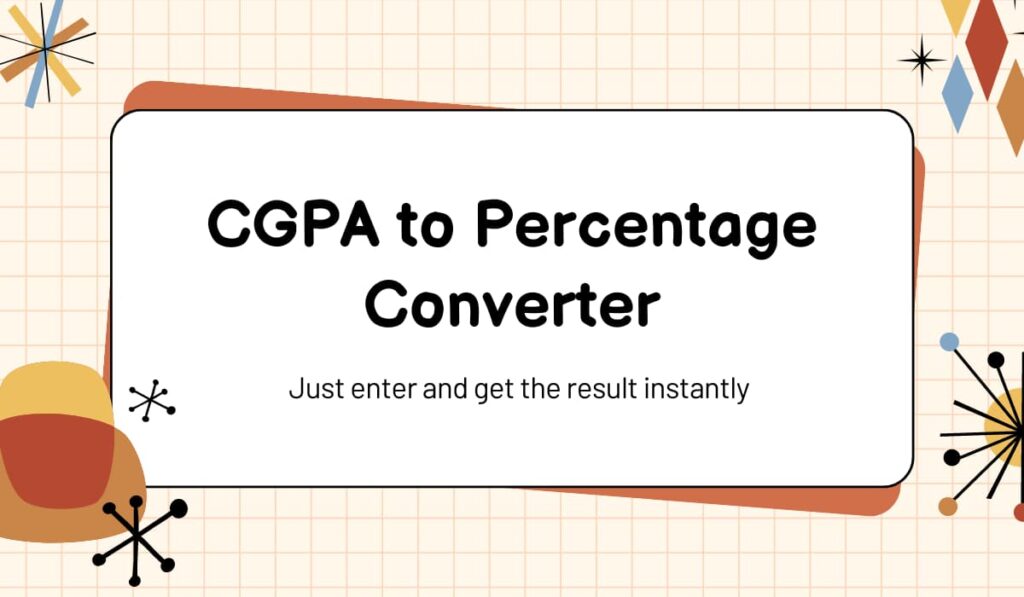
Calculating CGPA to Percentage is very easy, but calculating the percentages of individual subjects is time-consuming. But don’t worry, we have made a tool to do this conversion easily.
Enter your CGPA to convert it to Percentage
This tool will convert the total CGPA to Percentage. You just need to type the CGPA and click on the button to convert from CGPA to Percentage.
Similarly, you can also reverse the conversion, i.e. from Percentage to CGPA. Just enter the percentage you got and it will show your CGPA.
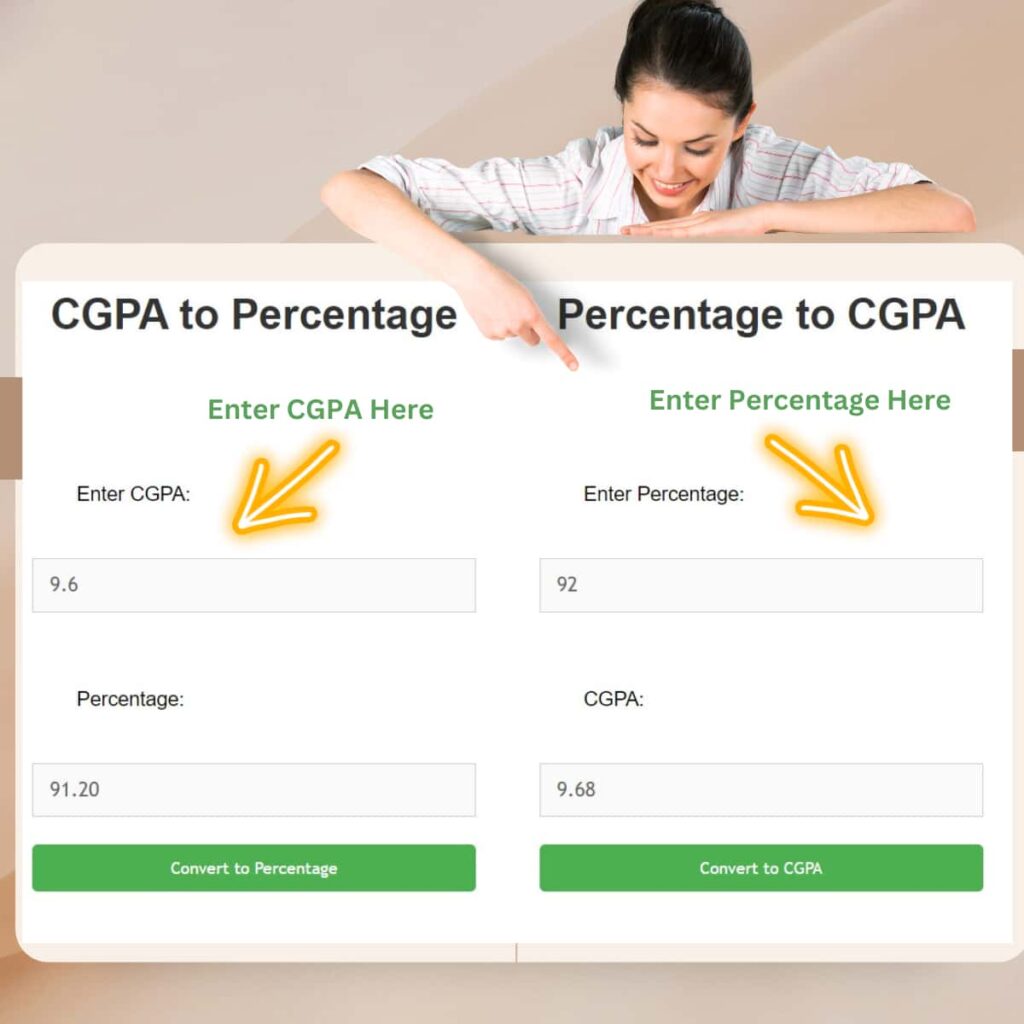
All you have to do is enter your CGPA and our tool will show you what it is in percentage form. We have also provided the reverse of it, I mean you can enter the percentage to get the CGPA.
We have also added many additional features, where you can enter the CGPA of individual subjects in our tool, and it will calculate the total CGPA and percentage.
Want the Best Result Check this tool:- Best CGPA to Percentage Calculator
Many colleges and Schools and even exam boards like CBSE, assign grades and CGPA to individual subjects. And if you want to get the overall Percentage then you can use this tool. As you can see here we have provided options:
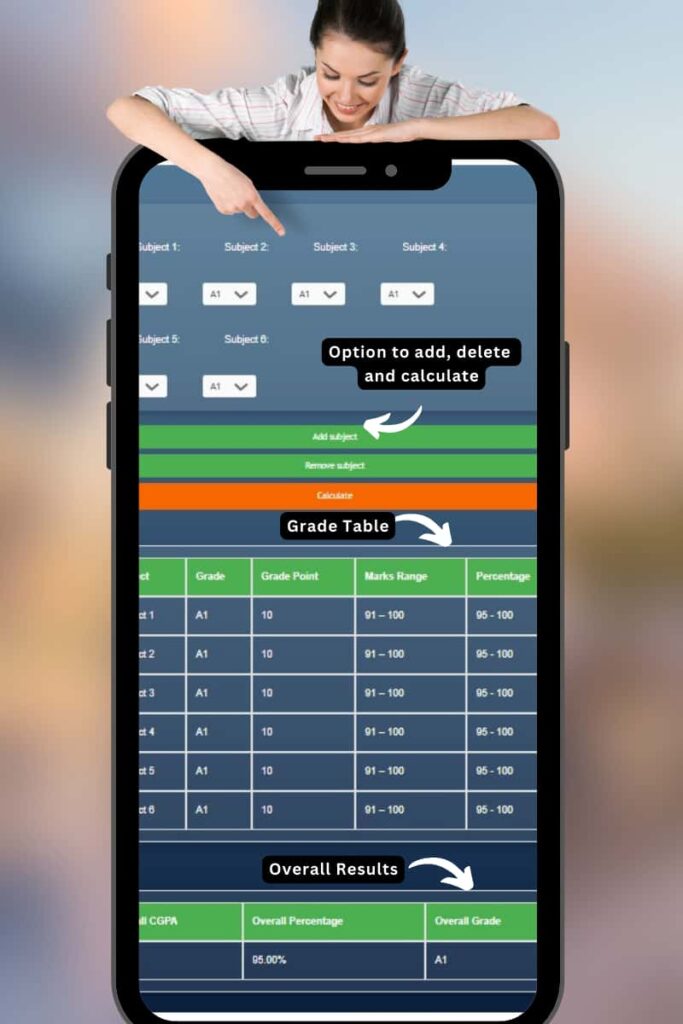
- To select Grades For Subjects
- To add or remove Subjects
After entering the data, click on the ‘Calculate‘ button to see the
- Grades in every subject
- Grade Points for every subject
- Marks range in every subject
- Percentage in every subject
Remember, CGPA is usually out of 10 points. But the way we show grades can be different in different places, so always check with your school/college to know the correct way. Anyways, here are the CGPA to Percentage Calculator tools.
Now let’s understand some basic details related to the topic of CGPA to Percentage converter tools.
Understand CGPA
Alright, let’s understand CGPA in a very simple way. The full form of CGPA is Cumulative Grade Point Average and it is a method many schools and colleges use to evaluate how a student is doing in their studies.
Now, let me simplify this even further. You know how in cricket, a batsman’s average is calculated, right? It’s not just about one big score in one match. It’s about all the runs scored over many matches. That’s exactly what CGPA does.
Let’s imagine your subjects as different cricket matches. Each subject is a different match. And your grade in each subject? That’s the runs you scored in that match. Now, CGPA is like the average runs of the batsman. It adds up all your ‘runs’ or grades from different ‘matches’ or subjects and then finds out the average.
So, when you see CGPA on your report card, it tells you your ‘average runs’ in your academic ‘matches’. It shows how you have been playing the game of studies, not just in one subject, but in all.
What is GPA?
Now coming to the GPA part let me explain to you with real-life examples. The GPA stands for Grade Point Average. It’s like the younger brother of CGPA. They are similar but there is a small difference between them.
Think about our cricket example again. CGPA is like the average runs scored in the entire series. But what if we want to know the runs scored in just one match? That’s what GPA is. It looks at your grades, or ‘runs’, in a shorter period. This could be one term or one year in your school or college.
Imagine you are watching a cricket match. Do you know how the commentators talk about a player’s performance in that one match? They will say something like, “Today, the player scored 50 runs.” That’s like GPA. It’s giving a snapshot, or a quick picture, of your performance in that particular term or year. It’s not about the entire series, it’s about that one match.
So, when you hear about GPA, remember it’s showing your academic performance in a shorter period. It is like the scorecard of one match in your academic journey.
In the next part, we will discuss what is a percentage and why one needs to change CGPA to a Percentage
What is the Percentage?
Let’s think about it this way. Suppose you’re playing a 100-ball cricket match. And you hit 80 runs. What’s your score? It’s 80 out of 100, right? That’s exactly what the percentage system is like.
If you score 80 marks on a paper out of 100, your percentage is 80%. Just like you scored 80 runs in a 100-ball match. It is as simple as that. No need to calculate averages or anything. You directly know your ‘runs’ or marks.
That’s why many people find the percentage system very easy to understand. It’s straightforward and clear. Just like knowing the score in a cricket match.
I know everybody knows what percentage means. But I think it is better to explain every term related to the CGPA to Percent conversion.
How to Convert CGPA into Percentage?
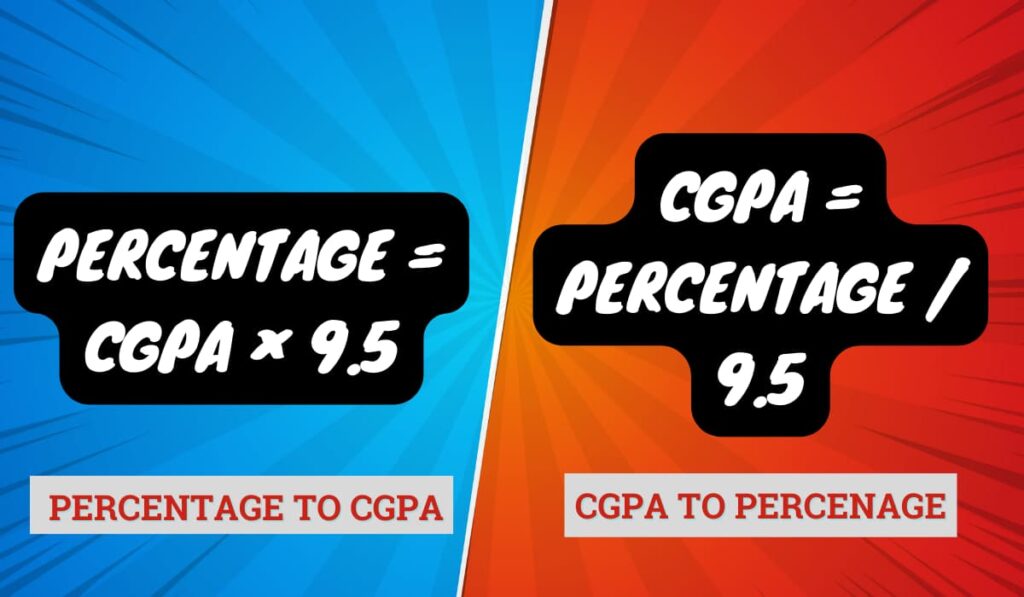
There are a few methods to convert CGPA to Percentage, but the most common one is a magic formula that became popular after CBSE declared the CGPA system. You just multiply the CGPA by 9.5.
Let’s say your CGPA is 8. Take that number and multiply it by 9.5 ( 8 X 9.5 = 76). So, your percentage would be 76%. That’s it! You have converted your CGPA into a percentage. This method is often used by the CBSE board. But remember, different boards and universities might use different formulas, so always double-check.
Sure, there are simple steps to convert CGPA into a percentage:
- Take your CGPA. For example, let’s say your CGPA is 8.4.
- Multiply your CGPA by 9.5.
- The formula is CGPA * 9.5 = Percentage.
- So, if we do this with our example: 8.4 * 9.5 = 79.8.
- The result is your percentage. In our example, 79.8 is the percentage.
Here is the formula to convert CGPA to Percentage
Percentage = CGPA × 9.5
So, if your CGPA is 8.4, your percentage is 79.8%. Remember, these steps can be used for the CBSE system. Other boards or universities might use a different method to convert CGPA into a percentage.
| CGPA (10-grade points scale) | Percentage |
|---|---|
| 10 | 95% |
| 9.5 | 90.25% |
| 9 | 85.5% |
| 8.5 | 80.75% |
| 8 | 76% |
| 7.5 | 71.25% |
| 7 | 66.5% |
| 6.5 | 61.75% |
| 6 | 57% |
| 5.5 | 52.25% |
| 5 | 47.5% |
| 4.5 | 42.75% |
| 4 | 38% |
| 3.5 | 33.25% |
| 3 | 28.5% |
| 2.5 | 23.75% |
| 2 | 19% |
| 1.5 | 14.25% |
| 1 | 9.5% |
Many colleges give CGPA on a 5-grade point scale. The conversion of CGPA to percentage on a 5-point scale can vary between institutions. However, a common method is to multiply the CGPA by 20. This is because the maximum grade point is 5 (representing 100%), so each grade point represents 20% of the total.
| CGPA (5-point scale) | Percentage |
|---|---|
| 5.0 | 100% |
| 4.5 | 90% |
| 4.0 | 80% |
| 3.5 | 70% |
| 3.0 | 60% |
| 2.5 | 50% |
| 2.0 | 40% |
| 1.5 | 30% |
| 1.0 | 20% |
| 0.5 | 10% |
Some popular conversions made by users using our CGPA to Percentage calculator
| CGPA | Percentage |
|---|---|
| 7.56 | 71.82% |
| 7.64 | 72.58% |
| 7.65 | 72.68% |
| 7.67 | 72.87% |
| 7.76 | 73.72% |
| 7.79 | 74.01% |
| 7.82 | 74.29% |
| 7.89 | 74.96% |
| 7.98 | 75.81% |
| 8.4 | 79.8% |
| 8.55 | 81.23% |
| 8.64 | 82.08% |
| 8.67 | 82.37% |
| 9 | 85.5% |
| 6.86 | 65.17% |
| 6.91 | 65.65% |
| 7.05 | 66.98% |
| 7.17 | 68.12% |
| 7.43 | 70.59% |
| 7.44 | 70.68% |
| 7.50 | 71.25% |
| 7.53 | 71.54% |
| 7.59 | 72.11% |
| 7.6 | 72.2% |
| 7.69 | 73.06% |
| 7.81 | 74.2% |
| 7.84 | 74.48% |
| 7.93 | 75.32% |
| 7.94 | 75.43% |
| 70 | 7.37 CGPA |
| 8.07 | 76.67% |
| 8.08 | 76.76% |
| 8.10 | 76.95% |
| 8.11 | 77.05% |
| 8.18 | 77.71% |
| 8.21 | 77.995% |
| 8.22 | 78.09% |
| 8.38 | 79.61% |
| 8.41 | 79.9% |
| 8.44 | 80.18% |
| 8.56 | 81.32% |
| 8.88 | 84.36% |
| 8.95 | 85.03% |
| 6.55 | 62.23% |
| 6.64 | 63.08% |
| 6.68 | 63.46% |
| 6.76 | 64.22% |
| 6.77 | 64.32% |
| 6.98 | 66.31% |
| 7.11 | 67.55% |
| 7.47 | 70.97% |
| 7.87 | 74.77% |
| 7.97 | 75.72% |
| 8.01 | 76.1% |
| 8.2 | 77.9% |
| 8.31 | |
| 8.32 | 79.04% |
| 8.40 | 79.8% |
| 8.5 | 80.75% |
| 8.53 | 81.04% |
| 8.58 | 81.51% |
| 8.59 | 81.61% |
| 8.62 | 81.89% |
| 8.69 | 82.56% |
| 8.76 | 83.22% |
| 8.8 | 83.6% |
| 8.84 | 83.98% |
| 9.2 | 87.4% |
| 9.25 | 87.88% |
| 6 | 57% |
| 6.2 | 58.9% |
| 6.36 | 60.42% |
| 6.43 | 61.09% |
| 6.48 | 61.56% |
| 6.54 | 62.13% |
| 6.56 | 62.32% |
| 6.58 | 62.51% |
| 6.59 | 62.61% |
| 6.62 | 62.89% |
| 6.71 | 63.75% |
| 6.72 | 63.84% |
| 6.79 | 64.51% |
| 6.84 | 64.98% |
| 6.87 | 65.27% |
| 7.37 | 70.02% |
| 7.5 | 71.25% |
| 7.51 | 71.35% |
| 7.8 | 74.1% |
| 7.9 | 75.05% |
| 8.3 | 78.85% |
| 8.49 | 80.66% |
| 8.7 | 82.65% |
| 9.13 | 86.74% |
| 9.4 | 89.3% |
| 7 | 66.5% |
| 6.14 | 58.33% |
| 6.18 | 58.71% |
| 6.39 | 60.71% |
| 6.41 | 60.9% |
| 6.42 | 60.99% |
| 6.46 | 61.37% |
| 6.7 | 63.65% |
| 7.2 | 68.4% |
| 7.4 | 70.3% |
| 6.22 | 59.09% |
| 6.24 | 59.28% |
| 6.37 | 60.52% |
| 6.8 | 64.6% |
| 7.78 | 73.91% |
| 7.9 | 75.05% |
| 8.36 | 79.42% |
| 8.7 | 82.65% |
| 8.99 | 85.41% |
| 9.6 | 91.2% |
| 5.91 | 56.15% |
| 6.08 | 57.76% |
| 6.11 | 58.05% |
| 6.5 | 61.75% |
| 7.1 | 67.45% |
| 7.3 | 69.35% |
| 7.7 | 73.15% |
| 8.1 | 76.95% |
| 9.3 | 88.35% |
| 7.46 | 70.87% |
| 7.48 | 71.06% |
| 7.58 | 72.01% |
| 7.46 | 70.87% |
| 7.48 | 71.06% |
| 7.58 | 72.01% |
How to Change Percentage to CGPA?
Sometimes we also need to do the opposite that is you need to convert a percentage back into CGPA.
To do this, you take your percentage and divide it by 9.5. For example, if you have got 85% in your exams, you divide 85 by 9.5 to get a CGPA of around 8.9.
Suppose you have got your exam results, and it’s given in percentage. But, your friend or your college wants to know your CGPA instead of your percentage.
Here’s how you do it:
- Take your percentage. Let’s say you’ve got 85% in your exams.
- Now, divide this percentage by 9.5. So, you do 85 divided by 9.5.
- The result you get is your CGPA. So, if you do the math, 85 divided by 9.5 is approximately 8.9. This is your CGPA.
Here is the formula to convert Percentage to CGPA
CGPA = Percentage ÷ 9.5
| Percentage | CGPA |
|---|---|
| 9.5% | 1.0 |
| 19.0% | 2.0 |
| 28.5% | 3.0 |
| 38.0% | 4.0 |
| 47.5% | 5.0 |
| 57.0% | 6.0 |
| 66.5% | 7.0 |
| 76.0% | 8.0 |
| 85.5% | 9.0 |
| 95.0% | 10.0 |
Grade – CGPA – Percentage
This table shows the conversions for Grade to CGPA and then CGPA to Percentage.
| Grade | CGPA | Percentage | Marks range |
|---|---|---|---|
| A1 | 10 | 95.0% | 91 – 100 |
| A2 | 9 | 85.5% | 81 – 100 |
| B1 | 8 | 76.0% | 71 – 80 |
| B2 | 7 | 66.5% | 61 – 70 |
| C1 | 6 | 57.0% | 51 – 60 |
| C2 | 5 | 47.5% | 41 – 50 |
| D1 | 4 | 38.0% | 33 – 40 |
| D2 | C (3) | 28.5% | |
| E | C (Failed) | < 28.5% |
In the next part, we will see why we need to convert CGPA and GPA into this percentage system and how we do it. So, keep reading.
We have developed a new tool for you to get the mobile number details of a number
Why Change CGPA into Percentage?

Like the previous parts let me answer this question by taking a daily life example. Imagine you have painted a beautiful picture. But the person you are showing it to only understands music, not art. So, you need to find a way to turn your picture into a song. That’s similar to why we convert CGPA into a percentage.
Sometimes, you need to show your grades to people or universities or jobs that only consider percentages. As I said this could be for a job application, or if you are applying to a university, especially one in a different country.
They want to see your grades in a way that they understand, which is sometimes as a percentage or sometimes as grades. In short, changing CGPA to a percentage makes it easier for others to understand your grades.
So why would you want to change CGPA into a percentage? You can also consider these points under Advantages
Advantages and Disadvantages of using Percentage
Advantages of using Percentage:
- Everyone understands it: Percentages are like a language that everyone speaks. No matter where you go in the world, people will understand what you mean when you say “I got 85%”. So, if you are applying for jobs or studying in another country, it’s helpful to have your grades in percentages.
- It’s clear and simple: Percentages are simple and easy to understand. They give a clear picture of how well you have done in your exams or studies. This can be especially helpful for people who are not familiar with the CGPA system.
- Easy to compare: Percentages make it easier to compare grades between different colleges or schools. This is because they are not affected by different grading systems like CGPA can be.
Advantages and Disadvantages of Using CGPA
Disadvantages of using Percentage:
There are no major disadvantages to using Percentage. But here are a few minor ones:
- Doesn’t Show Special Skills: With the percentage system, if you are very good in some subjects but not so good in others, it won’t show up. It counts all subjects the same.
- Big Ups and Downs: If you do well or not well in just one test, your overall percentage can change a lot. This can make you worry too much.
- Learning by Heart, Not by Mind: The percentage system can make you try to remember everything just to get high marks. This can be very stressful. But, with the CGPA system, you can understand your lessons better and keep your studies going steadily.
Advantages of CGPA:
- A Full Picture: CGPA gives you an overall view of a student’s performance. It’s like watching an entire movie. You get to see the whole story, not just parts of it. So, if a student has a high CGPA, it means they have been doing well consistently, not just in one or two exams.
- Fair and Balanced: CGPA considers all subjects equally. So, if a student is excellent in Maths but not so good in English, CGPA ensures that the Maths grades don’t overshadow the English grades, and vice versa. It’s a bit like a cricket team – every player’s contribution is important for the team’s total score.
Disadvantages of CGPA:
- Different Rules, Different Scores: Different schools use different ways to calculate CGPA. This can make it difficult to compare students from different schools. Imagine if two cricket teams played by different rules – it wouldn’t be fair to compare their scores, right?
- Hiding the Details: While CGPA gives a full picture, it also hides some details. For example, if a student is particularly good or bad at a specific subject, this is not clearly visible in the CGPA. It’s like trying to find a specific scene in a movie – if the movie is very long, you will miss that scene.
Use of grading system instead of CGPA and Percentage
Nowadays many universities assign grades to students. Now, let’s understand how this grading system work.
Well, instead of giving you exact marks or a percentage, they give you a grade. These grades are usually letters like A, B, C, and so on.
Let’s think about it like this. Imagine you are playing a match and at the end, instead of counting your exact runs, your coach says, “You played well”, “You played average”, or “You need to improve.” That’s what the grading system is like.
Each grade corresponds to a range of marks. For example, if your marks are between 90 and 100, you will be assigned the grade ‘A’. If your marks are between 80 and 89, you might get a ‘B’. This can change depending on your school or college’s rules, but this is the basic idea.
Now, each grade is also assigned a grade point. For example, ‘A’ might be 10 points, ‘B’ might be 9 points, and so on. When we talk about CGPA or GPA, we’re talking about the average of these grade points.
So, in the grading system, your exact marks are not as important as the range they fall in, and the grade you receive. It’s like the coach’s comments on your match.
Use of grading system in CBSE
The Central Board of Secondary Education (CBSE) uses a five-cum-nine-point scale grading system for the evaluation of student performance. In this system, A1 is considered the highest grade, while E is the lowest. This means, if we look at the grades, it starts with ‘A1’, then ‘A2’, ‘B1’, and ‘B2’, and goes on like that until we reach ‘E’
This grading system was introduced to replace the traditional score-based assessment. Instead of showing pass or fail status, students now receive grades. It’s a bit like running a race where everyone gets a medal, but the colour of the medal depends on the performance.
How does CBSE Convert CGPA to Percentage?
Let’s understand how it works. Consider a group of students who have passed an exam. These students are put in rank order. Now, the top 1/8th of these students get an ‘A1’ grade, the next 1/8th get an ‘A2’ grade, and so on. This continues until the last 1/8th, who gets a ‘D2’ grade. Students who have not passed the exam are given an ‘E’ grade.
| Grade | Grade Points | The proportion of Passed Students |
|---|---|---|
| A1 | 10 | Top 1/8th |
| A2 | 9 | Next 1/8th |
| B1 | 8 | Next 1/8th |
| B2 | 7 | Next 1/8th |
| C1 | 6 | Next 1/8th |
| C2 | 5 | Next 1/8th |
| D1 | 4 | Next 1/8th |
| D2 | C | Next 1/8th |
| E | C | Failed Candidates |
Five-point Grading for Art Education (Class 9th and 10th)
One important thing to note here is that the CBSE board also uses a different five-point grading system for assessing activities related to arts, health, and physical education for classes 9th and 10th. In these subjects, there are no specific indicators defined, and the grades given range from ‘A’ to ‘E’.
For example, in Art Education for Classes 9th and 10th, the grading is as follows:
| Grade | Connotation |
|---|---|
| A | Exemplary |
| B | Proficient |
| C | Developing |
| D | Emerging |
| E | Beginner |
Five-point Grading for Health and Physical Education (Class 9th and 10th)
Similarly, in Health and Physical Education, the grading scale used is from ‘A’ to ‘E’.
| Grade |
|---|
| A |
| B |
| C |
| D |
| E |
So, you see, the CBSE grading system offers a more comprehensive way to evaluate a student’s performance, giving a well-rounded view of their academic progress. This way, every student can understand where they stand and what they need to do to improve. It’s not just about passing or failing but about continuous development and learning.
CGPA to Percentage Conversion used by different boards and institutions.
Many colleges and universities use their own CGPA to Percentage conversion formulae. Here are a few examples.
- CBSE Board: To convert CGPA to percentage, the CBSE board follows the basic formula of multiplying the CGPA value by 9.5. For instance, if your CGPA is 8, the percentage is 8*9.5 = 76%.
- Sri Venkateswara University (SVU): This university in Andhra Pradesh uses a simple formula to convert CGPA into a percentage. You just multiply your CGPA by 10. For example, if your CGPA is 8, the percentage is 8*10 = 80%.
- University of Mumbai: The University of Mumbai uses the formula: CGPA*7.25 + 11 = Percentage(5). For example, if your CGPA is 8, the equivalent percentage is 7.25 * 8 +11 = 69%.
- Anna University: Anna University uses the formula: CGPA * 10 = Percentage. For example, if your CGPA is 8.7, the equivalent percentage is 8.7 * 10 = 87%.
- Visvesvaraya Technological University (VTU): VTU uses the formula: (CGPA – 0.75) * 10 = Percentage. For example, if your CGPA is 8.7, the equivalent percentage is (8.7 – 0.75) * 10 = 79.5%.
Now let’s know the difference between CGPA, GPA and Percentage
As for everything I have given you an example. Let us also understand the difference between the three terms by taking some common examples.
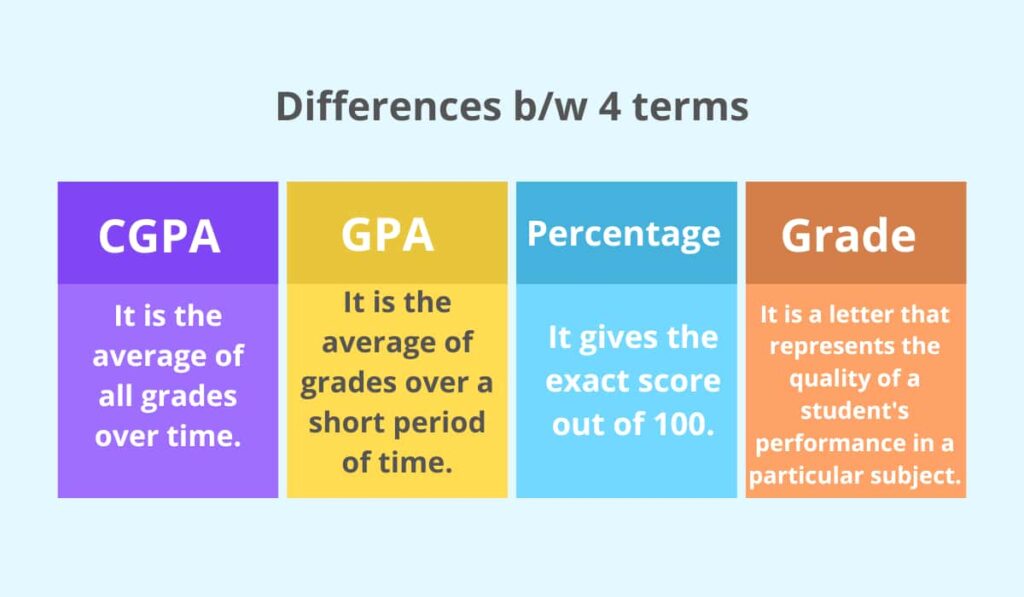
CGPA: Imagine you are eating from a big plate. There are many types of dishes on your plate. Now CGPA is like the taste of the whole plate. It takes into account all the dishes you eat from the beginning to the end of your meal. This gives you an idea of how delicious the food was.
GPA: On the other hand, GPA is like tasting one dish at a time. You might taste the dal first, then the sabzi, then the rice. Each time, you are judging the taste of that one dish, not the whole meal. This gives you an idea of how each part of the meal is, but not the whole picture.
Percentage: Then there’s the percentage. This is like knowing exactly how many spoons of rice or dal you have in your thali. It’s a very precise measure. If you have 80 spoons of rice out of 100, then your rice percentage is 80%. But this doesn’t tell you how tasty the rice or the rest of the meal is.
Grading: Grading is like giving a score to each dish on your plate. For example, you might say the dal is “great”, the sabzi is “good”, and the rice is “okay”. This is like your grades in school, where each subject gets a grade like A, B, or C.
Sure, let’s organize this information in a table for a clearer view:
| CGPA | GPA | Percentage | Grade | |
|---|---|---|---|---|
| Definition | It is the average of all grades over time. | It is the average of grades over a short period. | It gives the exact score out of 100. | It is a letter that represents the quality of a student’s performance in a particular subject. |
| Time Span | Short (semester/quarter) | Long (whole course) | The grade for a term | Specific term or course. |
| Conversion | Can be converted to CGPA or percentage | Can be converted to a percentage | Can be converted to CGPA or GPA | Grades are used to calculate both GPA and CGPA. Each grade has a corresponding point value (e.g., A=4, B=3, C=2, D=1, F=0). |
| Pros | Gives a big-picture view of academic performance. | Shows performance in a specific time frame. | Provides a very precise and direct measure of performance. | Provides a qualitative measure of performance in each subject. |
| Cons | May not highlight recent improvements or declines in performance. | Might not represent overall academic performance. | Might not reflect consistent performance over time. | Does not provide a precise numerical measure like a percentage. |
Where CGPA and GPA are used?
CGPA (Cumulative Grade Point Average) and GPA (Grade Point Average) are both systems used to measure a student’s academic performance, but they are applied and calculated differently. CGPA is used in countries like India, Pakistan, and Bangladesh, and it’s an average grade point obtained by a student across all semesters of their program, calculated on a 10.0 scale.
On the other hand, GPA is a measure of a student’s academic performance for a single semester or academic year. It’s calculated on a 4.0 scale and is used in many countries, including the United States.
GPA provides a detailed breakdown of a student’s performance in a single semester or academic year. It allows institutions to evaluate a student’s eligibility for academic honours, scholarships, and awards and can be used to compare a student’s performance across different semesters or academic years.
Final Words
Like everything, the CGPA system has its good and bad sides. But knowing what CGPA is, how to calculate it, and how to Convert CGP to Percentage can help you understand grades better.
Whether you are a student trying to understand your own grades, a parent keeping track of your child’s studies, or a teacher trying to give fair grades, our CGPA to Percentage Converter tool will help you and thereafter save you time.